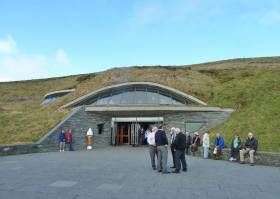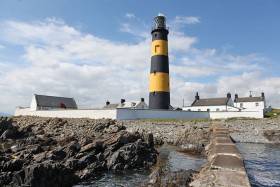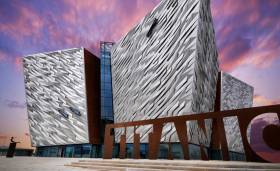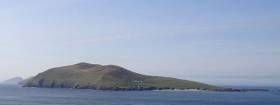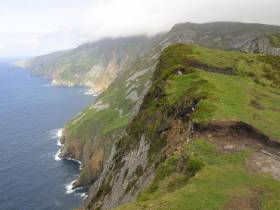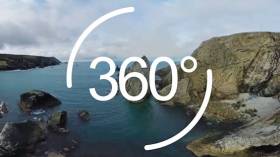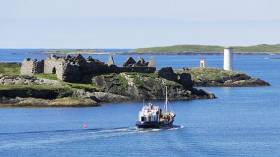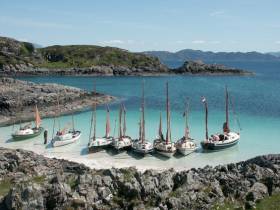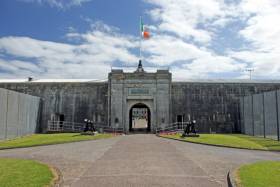Displaying items by tag: tourism
Daring Burglary At Cliffs Of Moher Visitor Centre
#CliffsOfMoher - As much as €20,000 in cash is believed to have been taken in a sophisticated burglary at the Cliffs of Moher Visitor Centre yesterday morning (Monday 3 October).
According to The Irish Times, the building’s security system was disabled after the daring thieves cut its electricity supply, allowing them unfettered access to the visitor centre at one of Ireland’s leading tourist attractions.
Visitors were yesterday warned away from the Co Clare coastal beauty spot while ESB Networks technicians worked to restore power.
The Irish Times has more on the story HERE.
Travel Writer Impressed By Ireland's Tallest Lighthouse
#Lighthouses - Guardian travel writer Yvonne Gordon was impressed by a recent visit to St John’s Point Lighthouse in Co Down, part of the Great Lighthouses of Ireland tourism initiative launched last year.
In operation since the Victorian era, the structure south of Killough is still a working lighthouse, but now visitors can stay in two of the former light keeper's cottages adjacent to the building.
The tallest lighthouse on Ireland's coastline at 40 metres, it also has a literary connection, as playwright and author Brendan Behan followed in his father's footsteps as a lighthouse painter when he helped slap a coat on the tower in 1950 – though not necessarily to the satisfaction of his employers.
The Guardian has more on the story HERE.
Top Travel Industry Award For Titanic Belfast
#TitanicBelfast - Titanic Belfast is Europe's leading tourist attraction, after scooping a top gong at a major industry awards ceremony.
Paying tribute to the ill-fated ocean liner RMS Titanic and its history in the city, the Belfast Lough visitor centre took the award for Europe's Leading Visitor Attraction at the World Travel Awards in Sardinia last night (Monday 5 September), according to TheJournal.ie.
The Guinness Storehouse, Buckingham Palace and the Colosseum in Rome were among the renowned tourist hotspots beaten to the prize, the first for Northern Ireland in the history of the awards.
As previously reported on Afloat.ie, the four-year-old venue saw a 2% growth in visitor numbers in the 12 months before March this year, along with a 7% growth in revenues.
#WildAtlanticWay - Minister of State for Tourism Patrick O’Donovan has announced almost €1.125 million in funding from Fáilte Ireland’s Capital Grants Allocation for two key projects along the Wild Atlantic Way.
A grant of is being made available to Galway County Council will receive €896,000 for the Connemara Greenway, while a grant of €225,000 is being allocated to the Office of Public Works (OPW) towards the first phase of development of new visitor facilities on Great Blasket Island.
“I am delighted to announce these grants today as these two important tourism attractions will provide a serious contribution to the future success of the Wild Atlantic Way," said the minister last Wednesday (13 July).
"Tourism moves in a very competitive global market and capital development is one means by which we can ensure that we are fighting fit to win a good portion of overseas visitors and, thereby, gain a return on this investment through increased revenue and jobs regionally.”
The grant for the Connemara Greenway will fund a new section of the route from Cloonbeg to Athry, running adjacent to Ballynahinch Castle, with a view to completion in May 2017.
This development is part of a wider plan for the Clifden to Oughterard Greenway that will link up with the planned Greenway from Galway city to Oughterard – ultimately resulting in a 78km Galway to Clifden Greenway offering a cycling experience from city to coast with international appeal for cycling enthusiasts.
The Blasket Centre, meanwhile, is located on the Wild Atlantic Way at the halfway point of the Slea Head Drive on the Dingle Peninsula. It was developed as a heritage and visitor centre honouring the unique community who lived on the remote Blasket Islands until 1953.
Currently there are no visitor facilities on the island but the new grant will assist the OPW in their overall development of the site by funding new facilities and services on the island, expected to be completed later this summer.
“These grants are an investment in the visitor experience on the ground," said Fáilte Ireland chief executive Shaun Quinn. "While the Wild Atlantic Way has been warmly received at home and abroad, it is still an evolving project. It is vital that we continue to invest in the project to ensure that we open up its full potential.
"We have great natural landscapes along the west coast but we must also ensure that we have top class tourism infrastructure, whether facilities or interpretation, to match them.”
Minister O’Donovan also recently launched a new Fáilte Ireland Grants Scheme for Large Tourism Projects, which will provide a pool of €65 million in investment to develop new, or boost existing, tourism experiences and attractions across Ireland.
The scheme, which will run from 2016-2020, is now open for applications from the public, private and voluntary sectors including community groups. Under the scheme, capital grants in excess of €200,000 and up to a maximum of €5 million will be available.
Donegal Launches New Atlantic Coastal Trail
#CoastalNotes - Donegal's history and relationship with the coastline are celebrated by a new coastal trail launched earlier this month.
As the Donegal Democrat reports, a special training programme has been developed for business owners and others along the new Atlantic Coastal Trail to "teach the people of this county to be proud of the story of Donegal", in the words of Údarás na Gaeltachta's Meadbh Seoige.
The Gaeltacht authority is one of a number of partners in the initiative to promote the county's "maritime leisure and seafood experiences" as highlighted by Donegal Cathaoirleach Terence Slowey.
"We’re working on where we fall short in visitor numbers," explained Donegal County Council chief executive Seamus Neely. "One statistic is that as little as 12% of tourists who visit the Wild Atlantic Way actually travel north of Galway city."
The Donegal Democrat has much more on the story HERE.
Wild Atlantic Way Now Welcoming Virtual Visitors
#WildAtlanticWay - Virtual reality views of some of the top destinations and attractions along the Wild Atlantic Way are now online, showcasing Ireland like it's never been seen before.
As previously reported on Afloat.ie, the 360-degree virtual tours were launched by Fáilte Ireland at the ITB Berlin travel fair in March, and promised an immersive experience for users of new VR gadgets like the Samsung VR and Oculus Rift.
But anyone with a smartphone and an inexpensive attachment like Google Cardboard can also explore the full list of breathtaking activities that includes surfing beneath the Cliffs of Moher and sea stack climbing at Donegal's Slieve League, according to the Irish Examiner.
The virtual reality videos can even be viewed on any computer desktop – simply click and drag on the screen as the videos play to see the sights from all angles.
The 360-degree virtual tours launch comes as news emerges that only a fraction of potential visitors to Ireland are aware of the Wild Atlantic Way.
Just 7% of tourists surveyed by Fáilte Ireland new of the initiative promoting the attractions of Ireland's Atlantic coast, according to Galway Bay FM – with officials promising to improve this figure to 20% amid calls for more towns along the route, like Salthill in Galway, to highlight their place on the map.
Inishbofin Ecotourism Award First For Irish Islands
#Inishbofin - Inishbofin has become the first Irish island to be recognised for its sustainable tourism efforts in an international awards scheme.
As The Irish Times reports, a number of the Connemara island's residents and local organisations will share in the Ecotourism award sanctioned by the Global Sustainable Tourism Council.
Angling, sailing and stand-up paddle boarding are some of the aquatic activities that helped clinch the accolade that's already gone to sustainable seaside attractions in Spiddal and Clifden.
In other news, county councillors are mooting a programme of safety works on slipways across Galway, according to Galway Bay FM.
The move follows the controversial restriction of access to the slipway at Galway Docks last month in the wake of the Buncrana tragedy in March.
Scottish Economy Benefits From Marine Tourism Billions
#Tourism - A new report from the Scottish government says the marine tourism sector is worth £3.7 billion (€4.7 billion) annually.
And more than a third of that spend is on water-based activities from sailing and surfing to kayaking, angling and marine wildlife watching, according to BBC News.
Businesses in the sector who contributed to the Scottish Marine Recreation and Tourism Survey say they are optimistic about growth over the next five years, coinciding with the industry's five-year action plan as previously reported on Afloat.ie.
As such, the Irish marine sector will be watching with interest to see how Scotland's strategy could inspire a boost in this country's burgeoning aquatic tourism industry – much in the same way Ireland's sailing tourism sector inspired the Scots five years ago.
BBC News has more on the story HERE.
Spike Island Set To Open For Summer Visitors
#CorkHarbour - Spike Island's new interpretive centre is scheduled to welcome its first visitors this summer, according to the Evening Echo.
As previously reported on Afloat.ie, Block B of the old prison building was earmarked for refurbishment as a visitor centre for what's hoped to be a major tourist attraction in Cork Harbour.
The first phase of these works, comprising a new pontoon and pier upgrades as well as a previously envisaged exhibition of military memorabilia, is now expected to be ready and open to the public by June.
A passenger ferry service from Cobh to Spike Island will also be running in time for the summer season.
The Evening Echo has more on the story HERE.
Wild Atlantic Way Goes Virtual Reality
#WildAtlanticWay - Very soon potential visitors to Ireland will be able to see the Wild Atlantic Way like it's never been seen before – in virtual reality.
Independent.ie reports on the new Fáilte Ireland initiative, launched at the ITB Berlin travel fair earlier this week, to provide 360-degree virtual tours of some of Ireland's most breathtaking coastal sites.
Users of brand-new virtual reality gadgets like the Samsung VR and the Oculus Rift will be able to fully immerse themselves in attractions such as cycling across the wilds of the Burren, or surfing at the foot of the Cliffs of Moher.
But the experience won't be limited to early adopters of technology, as the VR video tours will also be available on YouTube for anyone with a computer to explore at the click of a mouse.
Independent.ie has more on the story HERE.

